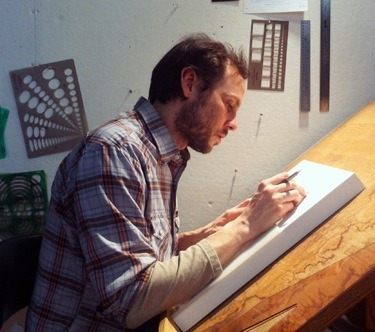Meet a NYFA Artist: Joseph Burwell
Joseph Burwell
NYFA talks to Joseph Burwell (2011 Printmaking/Drawing/Artists Books Fellow) about his influences, creative process and current exhibit, A Survey of Nonexistence at a Glance, on view through April 13, 2013 at Miyako Yoshinaga Gallery in Chelsea.
NYFA: You studied architecture and studio arts before pursuing an MFA in sculpture. It is clear that architecture, in particular, has greatly influenced your work as an artist. Which aspects of architecture do you find most compelling, and why?
JB: When I was thirteen I took a mechanical drawing class. I was certain I wanted to be an architect. When I got to college I was stunned by the buildings of Antoni Gaudí. They were surreal without depicting the human figure. I didn’t understand why more architects couldn’t work this freely.
The environment in the architecture department didn’t seem to nourish this type of creativity though. It felt uptight and oppressive. A very specific image of myself in the future appeared unexpectedly in my head: I was in the back of a white convertible and wearing a white turtleneck sweater. It was a bright sunny day and my arms were draped over two unknown friends. I threw my head back in laughter. It sounds like a happy scene but I felt like a villain. Soon after that I changed my major to studio art.
Studying sculpture you learn about the properties of materials and the physics of connecting them. This made for a natural segue from architecture to art, and the understanding of materials and those connections became an important part of my drawings. I am still interested in the psychological effects of architecture as well as its use as an historical instrument.

Sacrificial Office Plant, 2011
wood, metal, plastic, plant dirt, ceramic, fluorescent light
50" x 22" x 48"
NYFA: How do your sculptures, and process of creating them, integrate with your drawings and their process?
JB: For the drawings in this show I decided to work on wood panels prepared with gesso rather than on paper. Because of this more durable surface I didn’t worry too much about making changes. I could erase, sand, scrape, cut, or wash it and it would always leave a residual image that made the drawing more interesting.
That is helpful because these drawings are not premeditated. I start by collecting interesting images of a few architectural details and experiment in ways to fit them together. In this way the structures grow organically and the drawing becomes a thinking process.
Each type of building material represented is assigned its own medium. The layering of the different mediums creates a dissolving veil effect. In several images I drew scaffolding as a decorative element. I like the role reversal created here. The former agent of mutation had morphed into an integral part of the architecture. This transition from the functional to the decorative is a common evolutionary occurrence in architecture. My sculptures grow out of this aspect and are presented as archeological remnants.
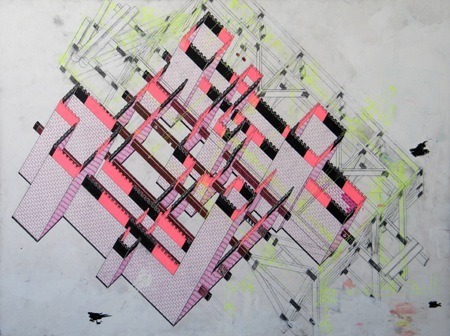
An Example of Mid-Century Medieval Modernism,
2011 pencil, pigment pen, and marker on wood panel, 18" x 24"
NYFA: In your current show, A Survey of Nonexistence at a Glance, we encounter certain structural motifs: the use of isometric projection, castle or fortress-like walls, enclosed, seemingly regenerative, mutating structures, scaffolding. We also find textural motifs such as wood grain and glass windows. Can you talk about your use of these motifs and their significance for you?
JB: The idea for this exhibit came from my drawing An Example of Mid-Century Medieval Modernism. It playfully inserts a nonexistent architectural movement into our history books. In the proceeding drawings, I allowed myself a gluttonous range of archaeology to cull from. In what could be called a buffet aesthetic, seemingly incongruous structures from different cultures and time periods are grafted onto each other and allowed to fester. There are only two basic identifying criteria: a manifestation of a medieval crenellated parapet wall, and a Modernist treatment of materials such as glass, steel, or plywood. Any additional influences were welcome embellishments.
I’ve always been drawn to medieval paintings and architecture. My use of isometric projection mimics the vertical perspective of medieval art and creates an unreal spatial understanding of a structure that allows you to see more of an object than is natural.
Modernism’s cold employment of glass and steel has always had a sinister psychological effect on me. It only made sense to compliment it with other historical examples of architectural violence, such as Aztec sacrificial pyramids and medieval siege towers. Archeology is a science of morbid fragments.
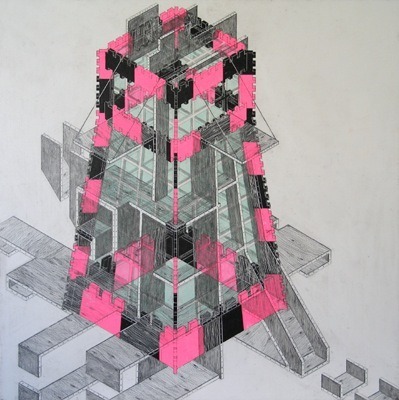
The Exact Location of a Sacrifice, 2012
pencil, pigment pen, and marker on wood panel, 18" x 18"
NYFA: You were born in Iceland and have lived in many places including Virginia, South Carolina, New Orleans and New York City. Do you think your experiences in these varied landscapes have impacted your work?
JB: Most of the southern cities that I’ve lived in are ghostly: Savannah, Charleston, New Orleans. They breed a certain temperament in the people who live there. There is some of that Southern Gothic in me and I have a tendency towards a heavy-handedness that I try to offset with humor, a sense of playfulness. It is present in the subjects and titles in my work but it is also present in the colors that I choose. My sense of color is important to the mood of my work. The vibrant, Caribbean-influenced colors of the buildings in these old Southern cities have influenced my own palette.
I was born on a NATO base in Iceland during the Cold War. My father was stationed there to monitor the movements of Russian submarines. We left when I was six months old. Although I was too young to remember Iceland, I am drawn to it as a fictional homeland. It has a pure place in my mind and is in my work, sometimes in disguise.
Iceland and New York serve as the bookends in my life up to now. New York is the city that consumes all other cultures. It affects everyone’s work that lives there and that is difficult to avoid. It is a place where all things come together and it helps you appreciate where you came from, and where you’ve been.
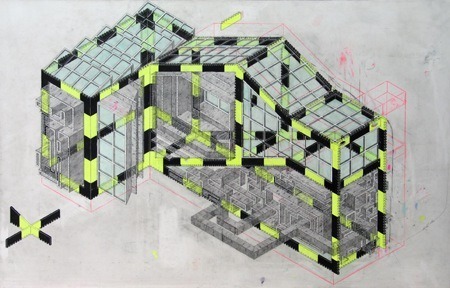
Isometric Funeral, 2012
pencil, pigment pen, and marker on wood panel, 27.5" x 43"
NYFA: Please tell us about your arts practice. What enables you to be the most productive?
JB: Momentum is the key for me to be productive. When I’ve been out of the studio for a too long it goes cold. To warm it back up I start working on something that I don’t really care about and at some point I start to care. All the best ideas come when I am working. Looking at other artists or going to a museum can excite me to get to work but the only thing that generates new work is making work.
I subscribe to the “Scientific Method”. Making art is an experiment and most scientists know that experiments seldom prove anything. They only lead to more experiments. My best work states nothing conclusive, it sets up the next work.
NYFA: You received a NYFA Fellowship for Printmaking/Drawing/Artists Books in 2011. What effects has the award had on your artistic career?
JB: There are several great benefits to being awarded a NYFA Fellowship. The benefit of the financial boost is obvious: It buys you time to make work. You can spend the money in a lot of different ways but it still buys the same thing.
The psychological boost is not to be underestimated. The reality of actually being paid to do what you enjoy doing most is the ultimate satisfaction. You immediately feel more confident and energized and this inevitably makes your work better.
Being awarded the fellowship also exposed me to the dynamic NYFA network. Through this network I was able to work with amazingly talented artists and curators on some impressive projects.
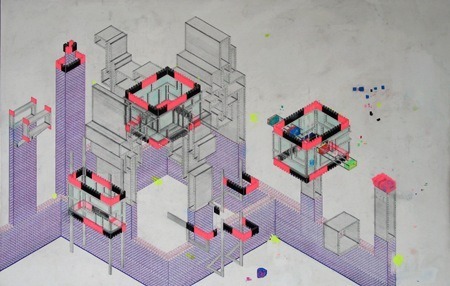
Tomb Design of the Late Period, 2013
pencil, pigment pen, and marker on wood panel, 27.5" x 43"
—Interview by Lara Hidalgo
Joseph’s exhibit, A Survey of Nonexistence at a Glance, was on view until April 13, 2013 at Miyako Yoshinaga Gallery in Chelsea. For more information on Joseph, please visit his website.

